Last updated on January 5th, 2025 at 02:54 pm
Thinking about upgrading your kitchen to a transitional design but not quite sure where to start? You’re not alone. Transitional kitchens have become a popular choice for homeowners looking to combine the best of both worlds—classic charm and modern simplicity. This guide will take you through the essentials of what makes a transitional kitchen stand out and how you can create one in your home. I will breakdown what defines a transitional kitchen, how to create one that suits your space, and tips on choosing the right materials, colors, and lighting. Whether you’re planning a full remodel or just looking to incorporate a few transitional touches, this guide will give you all the inspiration and advice you need to plan your transitional culinary sanctuary.
Defining the Transitional Kitchen
Simply put, a transitional kitchen is the perfect blend of traditional and contemporary design. It’s not too modern, nor is it overly classic—it sits comfortably in the middle. This balance is achieved through thoughtfully mixing clean, streamlined features with cozy, detailed touches.
Now before you start scratching your head, the transition itself starts when one phase starts to blend or combine with the other. But before you jump to conclusions, there are ground rules that help these two designs blend smoothly. With careful planning and a generous amount of mixing and matching techniques, you’ll have the perfect balance of design style.
Contemporary + Traditional = Transitional

The first item that you’ll notice about contemporary kitchens is the sleek and smooth cabinet doors. Everything is meant to look highly stylized and modern. There are no raised cabinet details other than handles and knobs that adorn each panel. Don’t expect to see any visible hinges, since many cabinets are meant to slide out or are hinged from the inside. Decorative appliances are built into the walls so they don’t ruin a flush and smooth design.
Traditional kitchens are totally opposite and feature ornate and decorative accents on cabinet doors. There is a home-like harmony of colors and wooden surfaces with no shortage of added decorations and appliances that adorn countertops and permeate the entire kitchen. Stepping into a traditional kitchen, you instantly feel there is an old-world charm with wooden cabinetry and marble-faced countertops.
Contemporary rules
- Lighting is often recessed but not limited to highly stylized hanging modern lamps
- Cabinets are largely smooth including solid stark colors including white, black, and earth-tone or neutral colors.
- Everything within contemporary kitchens is meant to not stand out looking detached
Traditional rules
- Hanging lamps that appear aged or antique
- Inset wooden cabinet doors provide plenty of visual appeal with rich wood grain or stains.
- Open shelving show off appliances and decorations that fill the entire kitchen
Pros and Cons

Before we get into the nitty-gritty of kitchen design styles, let’s start with some facts you’ll actually care about—because let’s be honest, making a decision about your new kitchen isn’t just about aesthetics, it’s about what’s going to work for you in the real world.
Pros:
- Always in Style: Transitional kitchens are like your favorite pair of jeans—they never really go out of fashion because they blend two design classics.
- Plays Well with Others: They fit into pretty much any home style or personal vibe, so you don’t have to commit to one “look” for the rest of your life.
- Just Right Vibes: Think Goldilocks—it’s not too modern and cold, not too traditional and fussy. It’s that sweet spot between trendy and timeless.
Cons:
- Style Jenga: Mixing modern and traditional can be tricky. Lean too far one way, and the whole balanced aesthetic thing falls apart. Proceed with caution (and maybe a Pinterest board).
- Pricey Taste: Quartz countertops? Wood cabinets? Steel accents? Yeah, it’s going to cost more than sticking to a single style. But hey, beauty isn’t cheap.
- Brain Power Required: Nailing that perfect blend of styles takes serious planning. Like, “where did all my free time go?” levels of effort. But if you’re up for the challenge, it’s worth it.
How to Make Your Kitchen Transitional

Now that you’ve got a good idea of what’s going on here, you can imagine where the fun starts with blending traditional and contemporary décor characteristics together. Creating a transitional kitchen design may seem daunting, but I’ll break it down with practical tips that highlight what I consider the essential elements of this style. Essentially, it’s about merging old-world charm with modern functionality to create a look that’s timeless and sophisticated.
Key takeaways from a transitional décor:
- Neutral color palettes: Think whites, beiges, and grays with occasional soft, earthy tones.
- Mixed materials: Warm wood cabinetry paired with sleek steel appliances.
- Minimal, yet decorative accents: Simple shaker cabinets combined with classic crown molding.
Here’s what you need to focus on:
- Color Palette: Stick to neutral shades like white, gray, and beige. Want to add some personality? Incorporate muted pastels like light blues or greens—they make the space feel airy without overpowering the design.
- Versatile Materials: Think wood for warmth, marble or quartz for elegance, and steel for that modern edge. Transitional kitchens love a mix of textures!
- Cabinetry: Opt for classic shaker-style cabinets with a mix of modern elements, like hidden hinges or sleek, brass hardware.
- Lighting: Combine recessed fixtures with statement pendants. Matte black or brushed steel light fixtures with glass accents fit perfectly.
- Countertops: Durable and chic options like quartz or granite bridge the gap between practical and stylish surfaces.
- Décor: Choose decorative touches wisely. Family heirlooms, simple pottery, or fresh herbs add just enough personality without crowding the space.
Breaking it Down
Basic layout
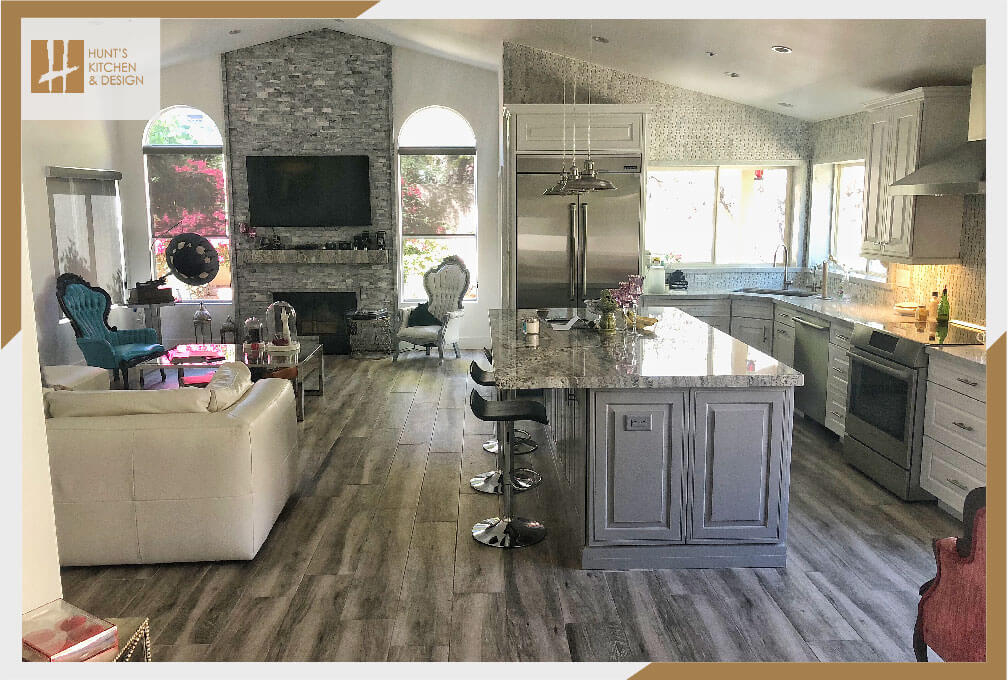
Not much is really changing in terms of the essential layout. What does need to be addressed is the mixture of traditional and contemporary. The most important point is to blend that simple and sleek look with decorative elements. This is not always an easy task, so the lines need to become a happy medium. This means there will need to be a subtle mix of wainscoting, corbels, and molding.
Angles and shapes
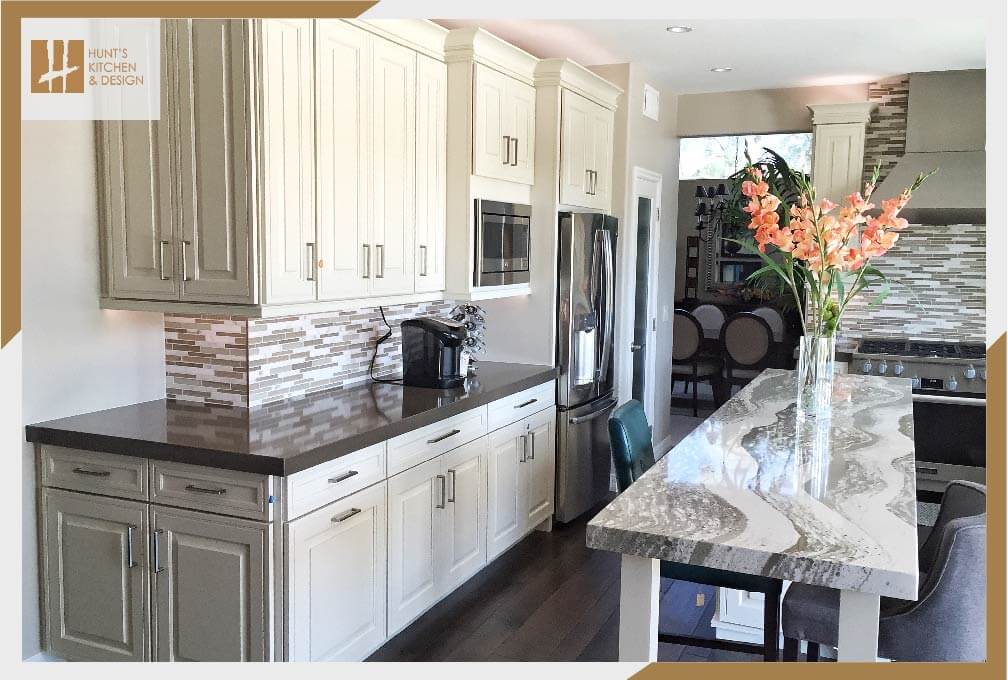
While any contemporary kitchen creates the sleek lines that continue wall to wall, this must appear to blend with a traditional kitchen layout. It will also need to be dialed back halfway so that it looks reminiscent of a contemporary look. The big difference is that cabinets retain as much traditional appearance likewise. It’s the difference between overwhelming and gaining equal attention.
“It combines curves with straight lines, it’s airy and polished , and it’s textured but not cluttered.” – Renee DiSanto | Park & Oak Interior Design”
What colors work best?
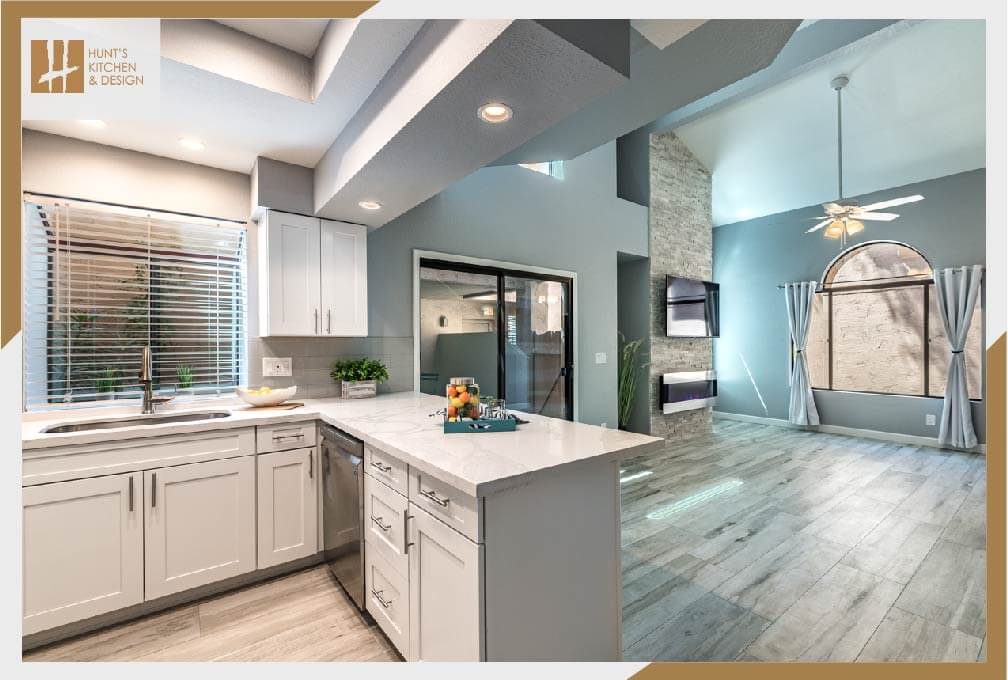

One point to follow is to include a fine line between neutral and pastel colors. As opposed to the rich wooden cabinets colors you see in a traditional kitchen. These are compromised to allow much more natural unfinished wood colors full of tan, and warm whites. You can still use distressed colors on cabinets, but these need to be relaxed enough to match the surrounding tones throughout the kitchen.
Countertops
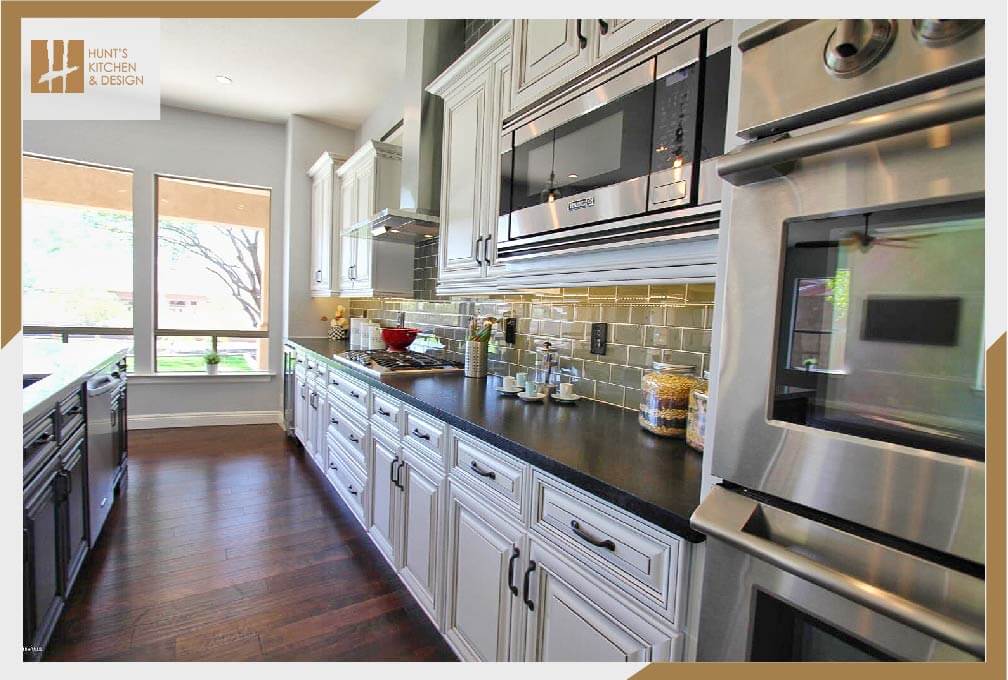
The good thing about these two styles is that marble and granite never fail to impress. There is always room to add Quartz-like sparkle and highly polished countertops. These can still allow angled and rounded edges and decorative beveled patterns. As long as you continue these countertops as a constant line it helps complete the contemporary sleekness without losing the traditional classiness and old-world charm.
Appliances
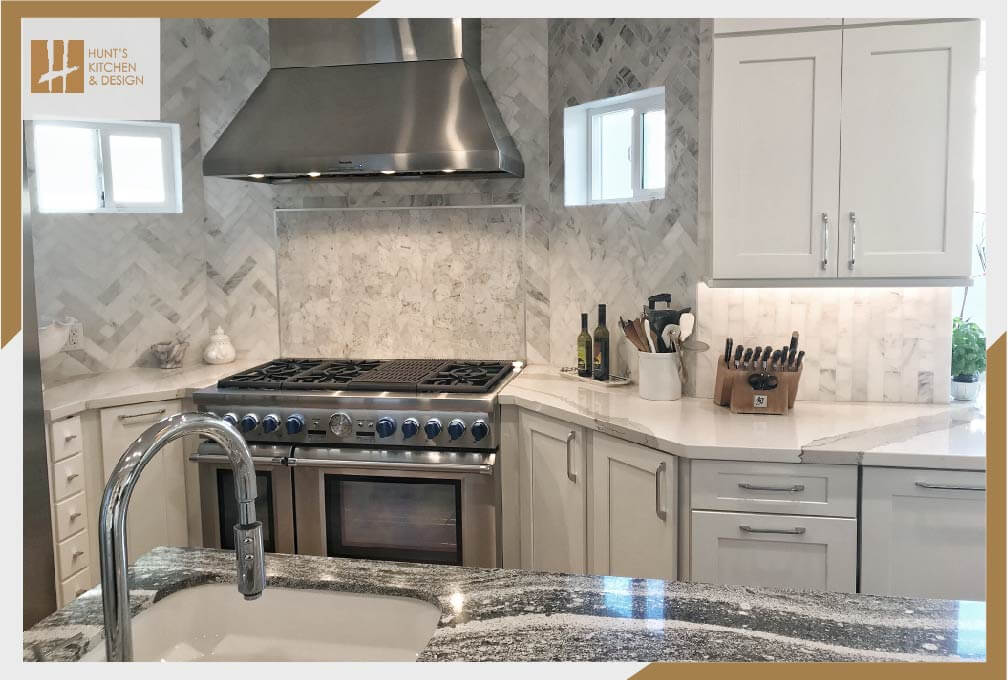
Items such as ovens, stovetops, and kitchen appliances often look invisible inside a contemporary kitchen. A transitional kitchen is exceptional since these can stick out slightly so there is a hint of traditional design happing here. The main difference is that these appliances look better when chrome and polished metal help give a blending effect so it doesn’t stick out visually and appears more chameleon-like instead.
Types of cabinets
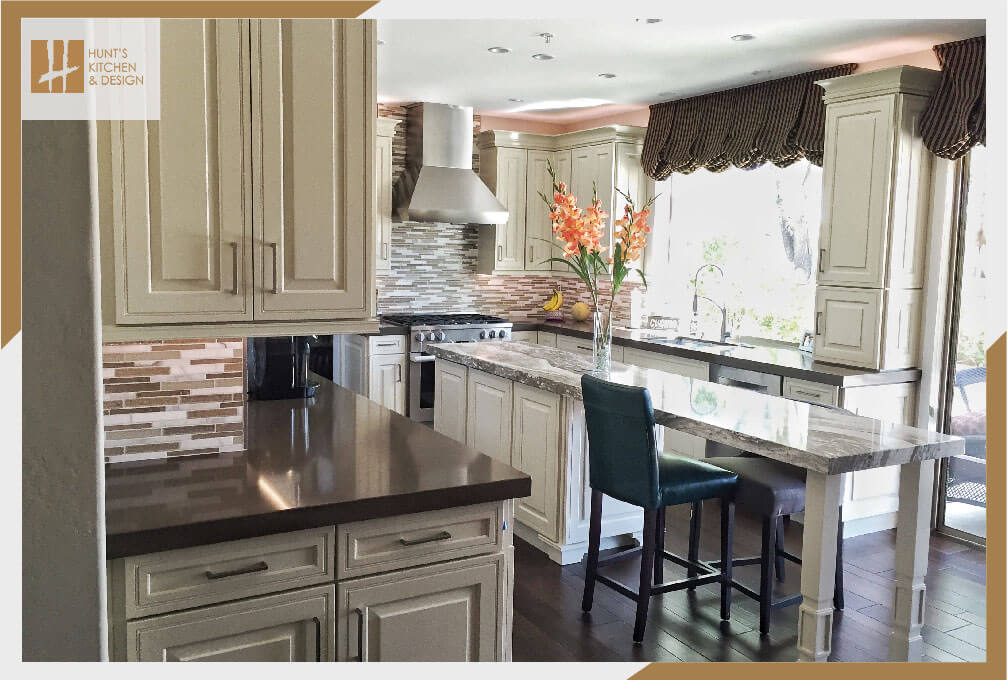
Luckily you can still have a 5-piece cabinet door with a center that allows for a framed edge. Cabinets should follow one rule that allows for the cabinets to touch the ceiling and includes decorative molding. While corbels are nowhere to be seen, decorative molded arches are allowed over window cabinet gaps. Cabinet doors should appear as flush as possible but do still have that inset edge that does give a hint of decorative framing. For more on designing custom cabinets see our page here.
The hardware and fine detail
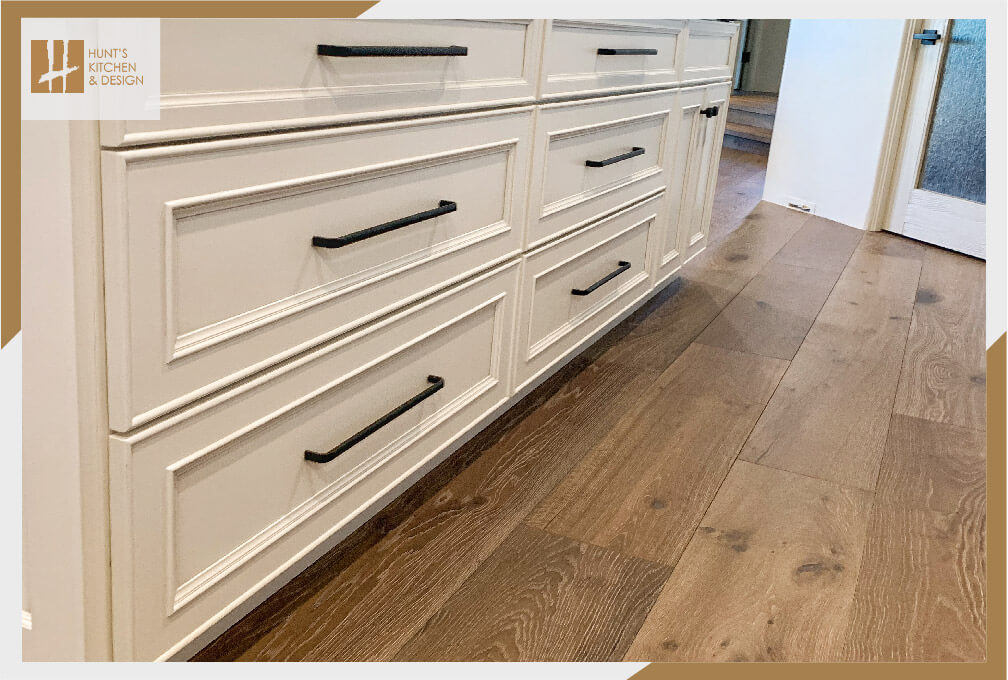
The transitional kitchen is still strict enough for not including exterior hinges, but handles and knobs are an exception. Chrome and polished brass are excellent choices since they also mimic the surface colors around them. This helps them to blend in and become somewhat invisible. Yet there are some exceptions if they don’t stand out with an overt design. This means it needs to follow your overall kitchen color design.
Flooring
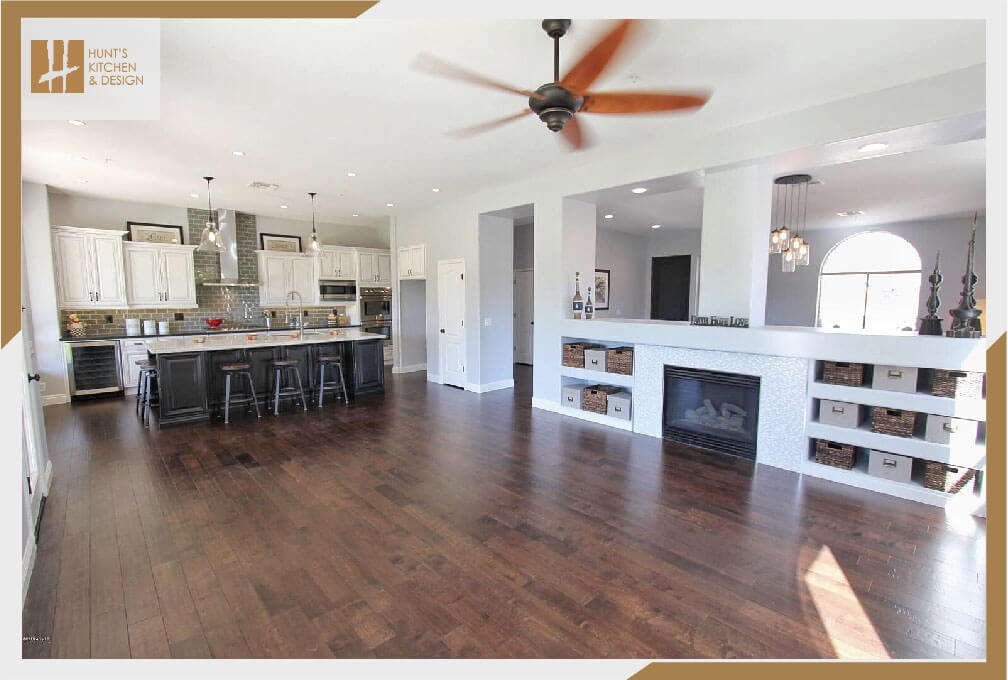
Your flooring needs to follow an opposite shade to the color of your cabinets. Light and natural cabinets will look better with a darker floor, whereas darker cabinets need a light-colored floor. It’s a matter of contract that helps frame your cabinets and help spread natural light accordingly. Natural wood floors and tiles that are highly polished look great in addition to neutral semi-gloss flooring material.
Best Practices for Creating a Transitional Kitchen

Designing a transitional kitchen is all about finding the perfect balance between traditional charm and modern functionality. To start, focus on functionality as your top priority. Every element you add — whether it’s a cabinet, piece of furniture, or appliance — should make your kitchen not just beautiful, but also practical and tailored to your needs.
Colors
Another hallmark of transitional design is sticking to a neutral and cohesive color palette. Classic shades like white, gray, or beige create a calming foundation while seamlessly tying together old and new elements. For a pop of personality, muted colors like soft blues or greens work beautifully on cabinets or small accent walls, keeping things interesting without becoming overpowering. Remember, moderation is key here — avoid the temptation to overload your space with too many loud tones.
Materials
When blending traditional and modern features, think balance rather than stark contrast. A polished quartz countertop can match perfectly with vintage-style wooden chairs or decorative molding. Similarly, mixing materials like wood, stone, and metal creates texture and visual interest. For instance, a stainless steel range hood can pair beautifully with a natural stone backsplash and elegant glass pendant lighting. This thoughtful harmony in materials and finishes is what truly defines the transitional aesthetic.
Lighting is another area where you can elevate your transitional kitchen. Layering different types of lighting — such as recessed lights for overall brightness, under-cabinet fixtures for task lighting, and pendant or chandelier-style lights for decorative flair — helps craft a dynamic, inviting atmosphere. Don’t shy away from statement lighting pieces; they often serve as the bridge between modern and traditional styles, tying the design together.
Finally, a designer’s secret to achieving a standout transitional kitchen is personalization. Incorporating unique pieces that reflect your taste or tell a story sets your space apart. Family heirlooms, custom artwork, or refurbished vintage furniture can add a deeply personal touch to the mix. Even small additions, like handcrafted ceramic bowls or antique drawer handles, can make your kitchen feel like a curated blend of past and present. Above all, the goal is to create a space that feels cohesive and functional while representing your personality.
Making a Transitional Kitchen Your Own

One of the best aspects of a transitional kitchen is its flexibility, allowing you to truly make the space your own while staying true to the timeless decor style.
The beauty of transitional design lies in its adaptability — blending modern efficiency with traditional charm opens up countless opportunities for customization. A designer’s secret to crafting a breathtaking transitional kitchen is personalization. Using unique pieces that reflect the client’s taste or tell a story sets their space apart. Family heirlooms, custom artwork, or refurbished vintage furniture can add a deeply personal touch to the mix. Even small additions, like handcrafted ceramic bowls or antique drawer handles, can make your kitchen feel like a curated blend of past and present.
As previously explained, the transitional kitchen is the king of the mix-and-match approach when it comes to materials, offering the chance to pair polished surfaces like quartz countertops with rustic wooden shelves or vintage-inspired lighting. This versatile style thrives on balance, ensuring that every unique touch seamlessly integrates with the foundational principles of the design, resulting in a kitchen that feels like a perfect blend of form and function, tradition and innovation.
Explore the Possibilities of a Transitional Kitchen

If you’re torn between preserving the classic charm of your space and incorporating sleek, modern touches, a transitional kitchen is the ideal solution. This style masterfully balances traditional elements with contemporary aesthetics, giving you a timeless design that’s as functional as it is beautiful. Whether you’re cooking a quiet family meal or hosting friends for a lively gathering, a transitional kitchen offers the versatility and sophistication needed to make every moment special.
Looking for inspiration? Check out our portfolio of completed transitional kitchens to see how we’ve helped clients turn their design dreams into reality. From elegant finishes to thoughtfully integrated details, our case studies showcase the possibilities. Each project is a testament to how transitional design can reflect personality, meet individual needs, and create unforgettable spaces.
- Show All
- Transitional
Ready to craft your dream kitchen? Schedule a consultation with us today at our Scottsdale showroom or contact us to get started. We’re here to guide you through every step of the process, from brainstorming creative ideas to achieving the perfect balance of tradition, innovation, and style tailored just for you. Don’t wait—your dream kitchen is just a call or visit away!







